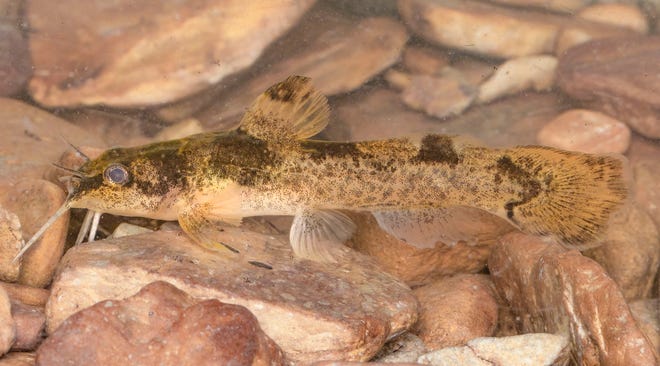Nature: Venomous madtom catfish a lesser known species in Ohio that packs a punch

The catfish is plenty good enough fish for anyone.
— Mark Twain
The catfish family includes a dozen species in Ohio waters, and some of them are among our best-known fishes. Their ranks include blue, channel and flathead catfish, and three species of bullhead.
Fishermen know these species well, and many people enjoy eating them. There’s lots of meat to be had on a lunker catfish. Blues and flatheads can exceed 100 pounds in weight, and the world-record blue catfish weighed 130 pounds! Unfortunately, in Ohio blue cats are found mostly in the Ohio River, and primarily between Cincinnati and Portsmouth. The Division of Wildlife does stock them in some lakes, including Hoover Reservoir.
Far less known is the other half of Ohio’s catfish family: the madtoms. While normally out of sight and mind, these tiny catfish recently made the news. On Oct. 16, 2023, the U.S. Fish & Wildlife Service pronounced the Scioto madtom extinct. In scientific parlance, the tiny fish is known as Noturus trautmani. The epithet honors legendary Ohio ichthyologist and naturalist Milton Trautman, who discovered the species in Big Darby Creek in 1943. A total of 18 specimens were collected in a short section of the Darby in Pickaway County between 1943 and 1957. Despite much searching, no one has found a Scioto madtom since.
Fortunately, five other madtom species ply our waters, although two are quite rare. The northern madtom is listed as endangered by the Ohio Division of Wildlife, and the mountain madtom is considered threatened. Both madtoms are known to exist in only a few stream systems and these species are very susceptible to water-quality degradation.
Three other species remain common, at least locally. Best-known of this enigmatic group of largely nocturnal fishes is the stonecat madtom. While normally 6 to 8 inches in length, a big stonecat can tape out at a foot. Stonecats also occur commonly in the islands region of western Lake Erie. While the third most common of our dozen catfish, stonecats are vulnerable to water pollution and declined dramatically in some streams in the early 1900s. Improvements in water quality has allowed them to recover somewhat.
Also common, including in many central Ohio streams, is the brindled madtom (pictured with this column). A handsome little catfish that normally peaks at about 4 inches in length, brindled madtoms are, like their brethren, nocturnal. They hide under rocks during the day, and emerge to hunt various invertebrate prey after dark.
More:A spider that can catch fish? It's true. Find out more about the species in Ohio
Probably the least known madtom is the tadpole madtom. A true elfin, the little fish measures but 2 to 3 inches in length. Further compounding the difficulty of finding one is its penchant for hiding in thick leafy debris. It’s possible that, like the Scioto madtom probably did, tadpole madtoms also shelter in crayfish burrows. Very few people, fishermen or otherwise, have encountered this furtive little fish. The vast variation in the catfish family is illustrated by this tiny species. It would take nearly 3,000 tadpole madtoms to equal the mass of the largest blue catfish!
A fascinating albeit painful facet of madtoms involves venom. That’s right, they are venomous catfish. The pectoral fins feature long stiff spines that are connected to basal venom glands. A careless or unaware handler is quite likely to get jabbed, as captured fish often wriggle their bodies rather violently from side to side. The “sting” has been likened to a wasp’s sting, and can last for several minutes.
Although I’ve handled a number of madtoms of several species, I have yet to be envenomated and cannot speak to the effect firsthand. However, while on a fish sampling excursion on the Scioto River years back with Ohio Department of Natural Resources zoologist Dan Rice and Ohio State University ichthyologist Ted Cavender, Ted got nailed by a brindled madtom. Dan and I observed Ted’s reaction with interest and it sure looked like it hurt, much as Ted tried to remain cool.
More:Nature: Predatory loggerhead shrikes no longer common in the Buckeye State
For the ultimate resource on Ohio’s fishes, get a copy of A Naturalist’s Guide to the Fishes of Ohio (Rice and Zimmerman (2019, Ohio Biological Survey). For an up-close look into an Ohio stream, visit the incredible 60-foot-long “living stream” aquarium at Battelle Darby Metro Park’s nature center.
Naturalist Jim McCormac writes a column for The Dispatch on the first, third and fifth Sundays of the month. He also writes about nature at www.jimmccormac.blogspot.com.